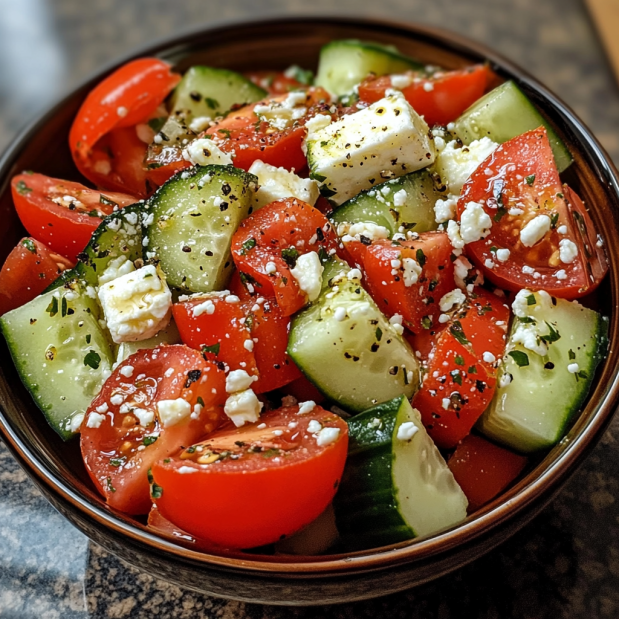Tomato Cucumber Feta Salad: Refreshing & Healthy Recipe
Introduction Tomato Cucumber Feta Salad
When it comes to creating a salad that’s both refreshing and satisfying, few options can match the simplicity and deliciousness of a Tomato Cucumber Feta Salad. This dish has become a staple in many households, particularly during the warmer months, thanks to its crisp texture, vibrant colors, and the harmonious blend of flavors. Whether you’re a seasoned chef or a beginner in the kitchen, this salad is incredibly easy to prepare and offers a multitude of variations that can suit anyone’s taste.
Not only is this salad delicious, but it also aligns perfectly with the principles of the Mediterranean diet, which is renowned for its heart-healthy benefits. The diet emphasizes the use of fresh vegetables, healthy fats like olive oil, and moderate amounts of dairy, all of which are featured in this salad. If you’re curious about the benefits of the Mediterranean diet, learn more about the Mediterranean diet and its benefits to understand why this salad is more than just a tasty dish—it’s a step toward a healthier lifestyle.
Ingredients Overview of Tomato Cucumber Feta Salad
The key to a great Tomato Cucumber Feta Salad lies in the quality of the ingredients. This dish doesn’t require any fancy or exotic components; instead, it relies on the freshness and natural flavors of its basic ingredients:
Tomatoes
- Tomatoes are the star of this salad, providing a juicy and slightly acidic bite that balances beautifully with the other components. When selecting tomatoes, it’s important to choose varieties that are ripe yet firm. Overripe tomatoes can become mushy when mixed into the salad, compromising the texture. Heirloom tomatoes, cherry tomatoes, or Roma tomatoes are all excellent choices.
Cucumbers
- Cucumbers add a refreshing crunch to the salad. The variety of cucumber you use can significantly affect the salad’s texture and flavor. English cucumbers are often preferred due to their thin skin and minimal seeds, but Persian cucumbers or regular slicing cucumbers can also be used. If you’re using cucumbers with a thicker skin, you may want to peel them to avoid a tough texture.
Feta Cheese
- Feta cheese is what brings this salad together, adding a creamy, tangy element that contrasts the crisp vegetables. Authentic Greek feta made from sheep’s milk has a rich, creamy texture that crumbles easily, making it ideal for this salad. However, if you prefer a milder flavor, you can opt for feta made from cow’s milk or even substitute it with a different cheese like goat cheese or mozzarella.
Olive Oil
- Olive oil serves as the base of the salad’s dressing. A high-quality extra virgin olive oil is recommended as it adds a rich, fruity flavor that complements the other ingredients. Olive oil is also a key component of the Mediterranean diet, contributing to the salad’s health benefits.
Red Onions
- Red onions provide a mild, sweet bite that enhances the overall flavor profile of the salad. Slicing the onions thinly ensures they don’t overpower the other ingredients. If you’re sensitive to the sharpness of raw onions, you can soak the slices in cold water for a few minutes before adding them to the salad to mellow their flavor.
Fresh Herbs
- Fresh herbs like basil or mint add a burst of freshness and elevate the salad’s flavor. Basil is a classic choice that pairs wonderfully with tomatoes, but mint can offer a refreshing twist. You can also experiment with other herbs like dill, parsley, or cilantro to suit your taste.
Lemon Juice or Vinegar
- Lemon juice or vinegar is used to add acidity and brightness to the salad. Lemon juice provides a fresh, citrusy flavor, while red wine vinegar or balsamic vinegar can add a tangy sweetness. The choice of acid can change the character of the salad, so feel free to experiment with different options.
These ingredients are essential for achieving the perfect balance of flavors and textures in your salad. Tomatoes are not only tasty but also packed with nutrients. Discover more about the nutritional benefits of tomatoes to appreciate their role in this healthy dish.
For an alternative cucumber salad that’s equally refreshing, you might also want to explore this Mexican Cucumber Salad for another fresh and flavorful delight.
Step-by-Step Preparation Guide to Tomato Cucumber Feta Salad
Preparation of Vegetables of Tomato Cucumber Feta Salad
- Tomatoes: Start by washing and drying your tomatoes thoroughly. Slice them into wedges or chunks, depending on their size. If you’re using cherry tomatoes, simply halve them. The goal is to create pieces that are bite-sized but still substantial enough to hold their shape in the salad.
- Cucumbers: Peel the cucumbers if necessary, then slice them into thin rounds or half-moons. The slices should be thin enough to allow for easy eating but not so thin that they lose their crunch. If you’re using an English cucumber, you can leave the skin on for added texture.
- Red Onions: Peel the onion and slice it as thinly as possible. If you find raw onions too pungent, consider soaking the slices in cold water for about 10 minutes to reduce their bite. Drain and pat dry before adding them to the salad.
Feta Cheese Handling of Tomato Cucumber Feta Salad
- Crumble the feta cheese directly over the salad using your fingers or a fork. It’s best to crumble it yourself rather than using pre-crumbled feta, which can often be dry and lacking in flavor. Freshly crumbled feta has a creamier texture that melds beautifully with the other ingredients.
- If you’re not a fan of feta, or if you’re looking to change things up, goat cheese or mozzarella can be excellent substitutes. Each offers a different flavor profile—goat cheese is tangy and soft, while mozzarella is mild and creamy.
Mixing the Salad
- Combine Ingredients: In a large mixing bowl, combine the sliced tomatoes, cucumbers, and red onions. Gently toss them together using your hands or salad tongs to ensure an even mix.
- Dress Lightly: Drizzle the extra virgin olive oil over the mixed vegetables. Start with a small amount, about 1-2 tablespoons, and add more if necessary. Follow with a squeeze of fresh lemon juice or a splash of vinegar. The key is to dress the salad lightly to allow the flavors of the fresh ingredients to shine through.
- Add Feta and Herbs: Sprinkle the crumbled feta cheese over the salad, followed by your choice of fresh herbs. Give the salad one last gentle toss to distribute the cheese and herbs evenly.
- Season to Taste: Finally, season the salad with a pinch of salt and freshly ground black pepper. Remember that feta cheese is already salty, so you may not need much additional salt.
Flavor Variations and Additions Tomato Cucumber Feta Salad
One of the joys of making a Tomato Cucumber Feta Salad is its versatility. While the classic recipe is delicious on its own, there are countless ways to customize the salad to suit your personal taste or the occasion. Here are a few ideas to get you started:
Mediterranean Twist
- Olives and Oregano: Add a Mediterranean flair to your salad by including pitted Kalamata olives and a sprinkle of dried oregano. The olives contribute a salty, briny flavor that pairs well with the feta, while oregano adds an earthy, herbal note. A splash of red wine vinegar can enhance this Mediterranean profile even further.
Protein-Packed Option
- Grilled Chicken or Chickpeas: To make the salad more substantial, consider adding a protein source like grilled chicken or chickpeas. Grilled chicken breast adds a savory, smoky element that complements the freshness of the salad. Chickpeas, on the other hand, are a great vegetarian option that adds a nutty flavor and additional fiber. Simply toss the protein into the salad or serve it on the side for a heartier meal.
Herb and Spice Enhancements
- Fresh Herbs: While basil and mint are popular choices, don’t hesitate to experiment with other herbs like dill, parsley, or cilantro. Dill adds a slightly sweet, grassy flavor that pairs well with cucumbers, while parsley offers a fresh, clean taste. Cilantro can introduce a citrusy, slightly peppery flavor that adds complexity to the salad.
- Spices: For an extra kick, consider adding a pinch of crushed red pepper flakes or ground black pepper. These spices can add a subtle heat that contrasts nicely with the coolness of the cucumbers and the creaminess of the feta.
Seasonal Additions
- Seasonal Fruits: In the summer, consider adding fresh fruits like watermelon or peaches for a sweet contrast. Watermelon pairs especially well with feta, creating a sweet-salty combination that is both refreshing and unique.
- Avocado: For a creamy texture, add slices of ripe avocado. Avocado’s richness pairs beautifully with the acidity of the tomatoes and the tanginess of the feta, making the salad even more satisfying.
Serving Suggestions of Tomato Cucumber Feta Salad
The Tomato Cucumber Feta Salad is a versatile dish that can be enjoyed in various ways. Here are some ideas on how to serve it:
Standalone Dish
- The salad can easily stand alone as a light lunch or dinner, particularly during the hot summer months when lighter meals are preferable. Its combination of vegetables, cheese, and healthy fats makes it a balanced and satisfying meal.
Side Dish
- Pair the salad with grilled meats like chicken, steak, or fish for a complete Mediterranean-inspired meal. The salad’s acidity and freshness make it a perfect complement to rich, savory dishes. For a vegetarian option, serve the salad alongside a hearty grain like quinoa or farro.
Appetizer or Starter
- Serve the salad as an appetizer at your next dinner party. Its vibrant colors and fresh flavors make it an appealing starter that whets the appetite for the courses to come.
Picnic or Potluck
- This salad is also an excellent choice for picnics or potlucks, as it can be made ahead of time and holds up well without wilting. Just be sure to add the dressing right before serving to keep the salad crisp.
Perfect Presentation Tips
To make your salad visually appealing, consider the following presentation tips:
- Layered Presentation: For a more formal presentation, layer the tomato and cucumber slices on a large platter, alternating between the two. Scatter the red onion slices, feta cheese, and herbs over the top, then drizzle with olive oil and lemon juice. This method allows each ingredient to be seen and appreciated.
- Garnishing: Garnish the salad with whole olives, a sprig of fresh herbs, or a few extra crumbles of feta for a finishing touch. A sprinkle of crushed red pepper flakes can also add a pop of color and a hint of spice.
Health Benefits to Tomato Cucumber Feta Salad
The Tomato Cucumber Feta Salad is not only a delight for the taste buds but also packed with numerous health benefits. Let’s delve into why this salad is a great addition to your diet:
Nutritional Breakdown Tomato Cucumber Feta Salad
- Tomatoes: Rich in vitamins A, C, and K, as well as antioxidants like lycopene, tomatoes are a powerhouse of nutrients. Lycopene, in particular, has been linked to reduced risk of chronic diseases such as heart disease and cancer. The high vitamin C content also supports a healthy immune system.
- Cucumbers: Cucumbers are low in calories but high in vitamins and minerals, including vitamin K, potassium, and magnesium. They are also incredibly hydrating, as they are composed of about 95% water. This makes them an excellent addition to a weight management diet, helping you feel full without consuming many calories.
- Feta Cheese: Feta cheese is a good source of calcium and protein, both of which are essential for maintaining healthy bones and muscles. Although feta is a full-fat cheese, it contains conjugated linoleic acid (CLA), a fatty acid that has been shown to reduce body fat in some studies.
- Olive Oil: Extra virgin olive oil is one of the healthiest fats you can consume. It’s rich in monounsaturated fats, which are beneficial for heart health. Olive oil is also packed with antioxidants, including vitamin E, which protects your cells from oxidative damage.
Impact on Heart Health Tomato Cucumber Feta Salad
The combination of fresh vegetables and olive oil in this salad aligns perfectly with the heart-healthy principles of the Mediterranean diet. Regular consumption of this diet has been linked to lower risks of heart disease, stroke, and high blood pressure.
- Lycopene in Tomatoes: The lycopene found in tomatoes has been shown to reduce LDL (bad) cholesterol levels and blood pressure, both of which are major risk factors for heart disease.
- Healthy Fats from Olive Oil: The monounsaturated fats in olive oil help to reduce inflammation and improve cholesterol levels, further protecting against heart disease.
Weight Management Tomato Cucumber Feta Salad
This salad is an excellent choice for those looking to manage their weight. It’s low in calories but high in fiber and water content, making it filling without being heavy. The combination of vegetables, protein from feta, and healthy fats from olive oil helps to keep you satisfied for longer periods, reducing the likelihood of overeating.
- Hydration: The high water content in cucumbers and tomatoes also helps to keep you hydrated, which is essential for overall health and can help prevent overeating due to thirst mistaken for hunger.
If you’re interested in preserving your vegetables for future use, learn about Frozen Zucchini Recipes to make the most of your fresh produce.
Common Mistakes to Avoid Tomato Cucumber Feta Salad
Even a simple salad like the Tomato Cucumber Feta Salad can go wrong if not prepared correctly. Here are some common mistakes to avoid:
Overdressing the Salad
- One of the most common mistakes is overdressing the salad. Adding too much olive oil or lemon juice can make the salad soggy and overpower the fresh flavors of the vegetables. It’s best to start with a small amount of dressing and add more if needed.
Incorrect Ingredient Ratios Tomato Cucumber Feta Salad
- Balancing the ingredients is key to a great salad. Too much tomato or cucumber can overwhelm the other flavors, while too little feta can make the salad taste bland. Aim for equal parts tomato and cucumber, with a generous sprinkle of feta and herbs to tie everything together.
Not Seasoning Properly Tomato Cucumber Feta Salad
- While feta cheese adds a good amount of saltiness to the salad, it’s still important to taste and adjust the seasoning. A pinch of salt and a few grinds of black pepper can make a big difference in bringing out the flavors of the ingredients.
Using Low-Quality Ingredients
- Since this salad relies on the freshness of its ingredients, using subpar tomatoes, cucumbers, or olive oil can result in a lackluster dish. Always opt for the best quality produce and olive oil you can find.
Not Letting the Salad Rest
- While it’s important not to overdress the salad, it’s equally important to let the salad rest for a few minutes after dressing. This allows the flavors to meld together and can improve the overall taste of the salad. However, don’t let it sit for too long, as the cucumbers and tomatoes can release too much water, making the salad soggy.
FAQs
What is the best type of cucumber to use?
- Answer: English cucumbers are preferred for their thin skin and minimal seeds, which result in a smoother texture. However, any variety of cucumber can be used, including Persian cucumbers or regular slicing cucumbers. If using a cucumber with thicker skin, consider peeling it to avoid a tough texture.
Can this salad be made ahead of time?
- Answer: Yes, but it’s best to add the dressing just before serving to keep the salad fresh and crisp. If making the salad ahead of time, store the chopped vegetables and crumbled feta in the refrigerator and dress the salad right before you plan to eat it.
What other types of cheese can be used?
- Answer: While feta cheese is the traditional choice, other cheeses like goat cheese or mozzarella can be used as substitutes. Goat cheese offers a tangy, creamy texture, while mozzarella is milder and slightly stretchy, which can add a different mouthfeel to the salad.
How long does this salad last in the fridge?
- Answer: The salad can be stored in the fridge for up to 2 days. However, it’s best enjoyed fresh. If you must store it, keep the dressing separate until you’re ready to serve to avoid sogginess.
Is this salad suitable for a low-carb diet?
- Answer: Absolutely! This salad is low in carbs, making it a perfect option for those following a low-carb or keto diet. The high content of vegetables, combined with the healthy fats from olive oil and the protein from feta cheese, makes it a balanced and nutritious choice for low-carb dieters.
Conclusion
The Tomato Cucumber Feta Salad is much more than just a simple side dish; it’s a versatile, healthy, and flavorful meal that can be adapted to suit a variety of tastes and dietary needs. Whether you’re serving it as part of a larger Mediterranean feast, enjoying it on its own as a light lunch, or bringing it to a potluck, this salad is sure to be a hit.
The combination of fresh, crisp vegetables, creamy feta cheese, and the rich flavor of olive oil makes this salad a standout dish that you’ll want to make again and again. By using the highest quality ingredients and following the simple preparation steps outlined above, you can create a salad that is not only delicious but also packed with nutrients that support overall health.
So, next time you’re looking for a quick, healthy, and satisfying meal, give this Tomato Cucumber Feta Salad a try. Whether you stick to the classic recipe or experiment with some of the variations and additions suggested here, you’re sure to create a dish that delights the palate and nourishes the body.







